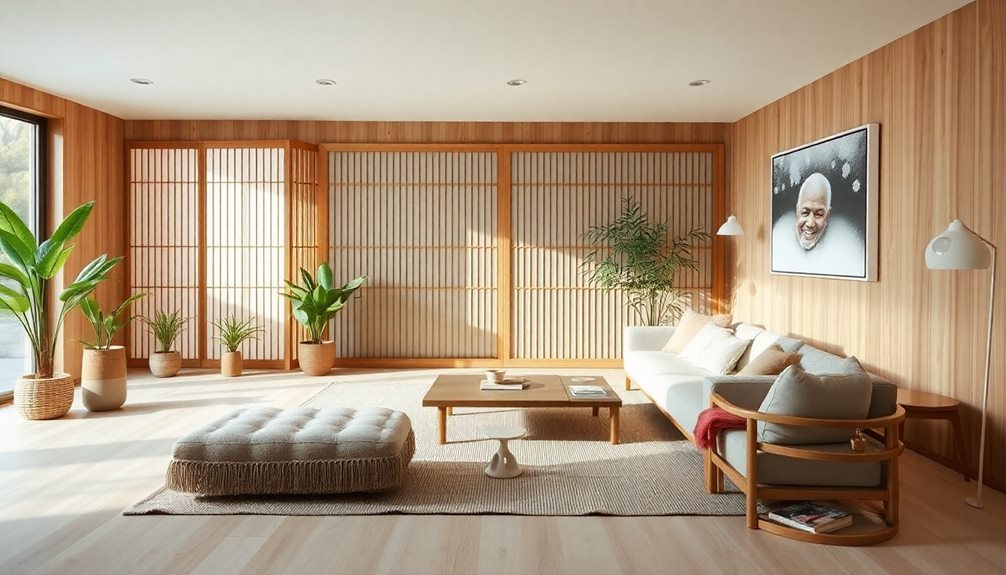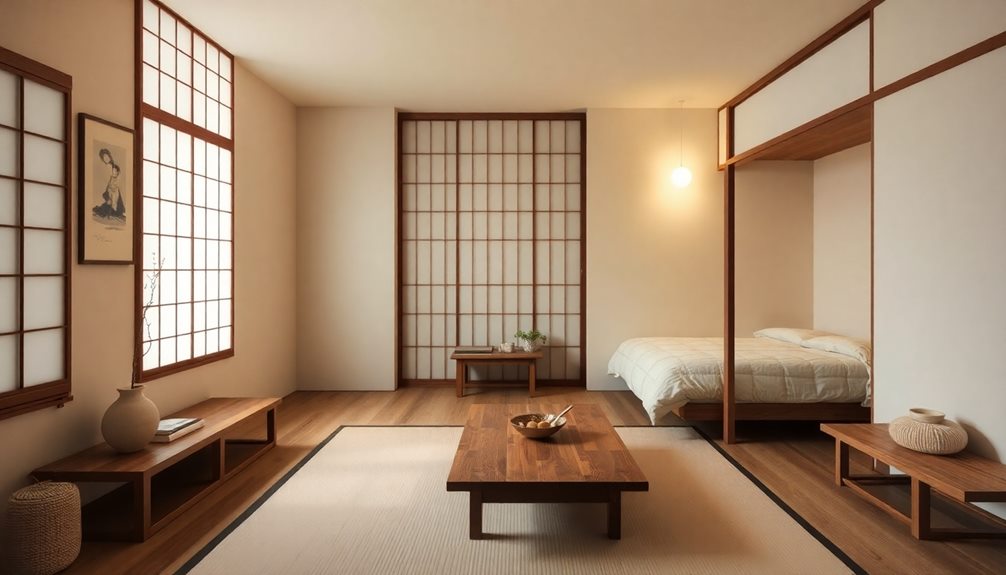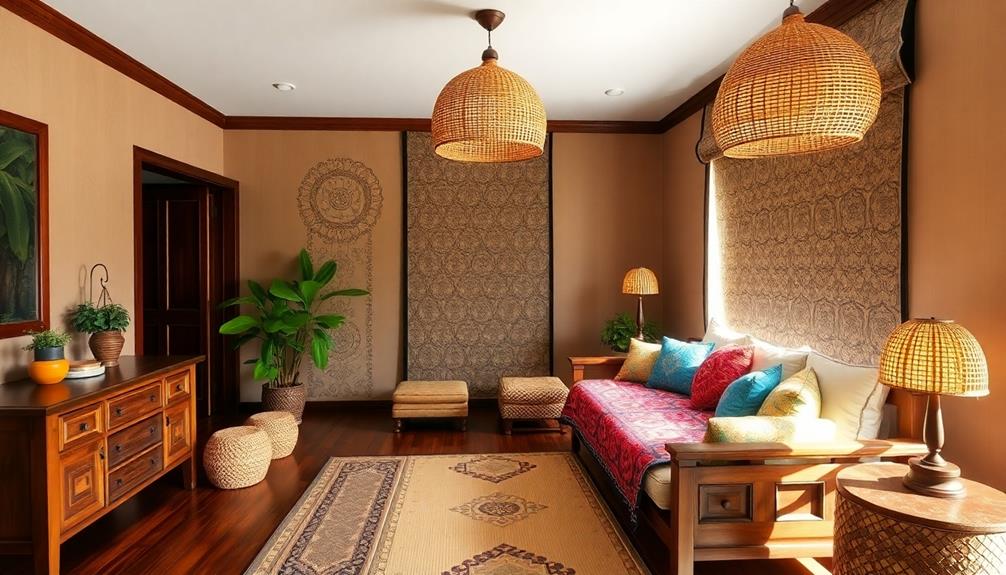To maximize small spaces with a Japanese-inspired aesthetic, focus on simplicity and functionality. Choose multifunctional furniture like storage ottomans and wall-mounted shelves to save space. Stick to a neutral color palette of soft whites and earthy tones to create a calming environment. Incorporate natural elements like wood and indoor plants for warmth and tranquility. Use effective lighting techniques, such as sheer curtains and strategic mirror placement, to enhance openness. Aim for a clutter-free space that flows smoothly, marrying beauty with practicality. There's plenty more to explore that can help you refine your aesthetic further.
Key Takeaways
- Embrace Japandi design principles by blending Japanese minimalism with Scandinavian functionality for serene and clutter-free spaces.
- Utilize multifunctional and space-saving furniture, such as storage ottomans and foldable tables, to maximize utility in small areas.
- Opt for a neutral color palette with soft whites and earthy tones to enhance spaciousness and maintain a tranquil atmosphere.
- Incorporate natural elements like wood, bamboo, and indoor plants to create warmth, sustainability, and a connection to nature.
- Implement effective lighting techniques, including soft ambient light and mirrors, to enhance openness and the illusion of larger spaces.
Understanding Japandi Design Principles

Understanding Japandi Design Principles
Embracing the essence of tranquility, Japandi design principles blend Japanese minimalism with Scandinavian functionality to create serene living spaces. This aesthetic emphasizes simplicity and the art of maximizing space, allowing you to enjoy a clutter-free environment.
By focusing on natural materials like wood, bamboo, and stone, Japandi design fosters warmth and sustainability, making your small spaces feel inviting and grounded. Decluttering spaces is essential in achieving this aesthetic, as it reduces stress levels and enhances focus within your home.
A neutral color palette, featuring soft whites and earthy tones, serves as the foundation of this style, enhancing tranquility and the perception of spaciousness. You'll find that decluttering is central to achieving harmony in your home, as each piece of furniture and decor serves a purpose.
Incorporating multifunctional furniture allows you to maintain an organized, open feel while catering to your lifestyle needs.
Additionally, organic shapes are prevalent in Japandi interiors, adding authenticity and a tactile quality. Handcrafted items contribute to a cohesive and uncluttered aesthetic, creating a peaceful atmosphere that promotes mental clarity.
Space-Saving Furniture Options

When you're working with limited space, choosing the right furniture can make all the difference in achieving a Japandi-inspired aesthetic. Look for multifunctional furniture, like storage ottomans and convertible tables, to maximize utility without sacrificing style. These pieces embody the minimalist aesthetic of Japandi design, ensuring simplicity and efficiency in your space.
Incorporating transformative decor ideas can further enhance the ambiance of your room, creating a calming atmosphere that complements your furniture choices.
Consider wall-mounted shelves and higher shelving units to effectively utilize vertical space. This keeps your floors clear, promoting an open and airy feel in compact rooms.
Foldable furniture options, such as Murphy beds and collapsible dining tables, offer versatile solutions that can be easily stored away when not in use, enhancing functionality.
Opt for low-profile furniture with clean lines, which not only enhances spatial perception but also aligns with Japandi principles.
Investing in storage-integrated pieces, like beds with built-in drawers and modular furniture, helps keep clutter concealed while maintaining a cohesive, organized aesthetic in small living areas.
Color Palettes for Small Spaces

Choosing the right color palette can dramatically impact how your small space feels and functions. For Japanese-inspired interiors, a neutral color palette featuring soft whites, warm beiges, and light grays creates an illusion of spaciousness and tranquility. Incorporating muted pastels, like pale blues or soft greens, adds warmth and depth without overwhelming the visual space.
Here's a table illustrating effective color combinations for small spaces:
| Color Type | Examples |
|---|---|
| Neutral Palette | Soft whites, light grays |
| Muted Pastels | Pale blues, soft greens |
| Darker Shades | Navy, forest green |
| Reflective Surfaces | Light-colored mirrors |
| Layering Textures | Textiles in neutral tones |
You can also use darker shades as accent colors to create contrast while maintaining a cohesive aesthetic. Reflective surfaces amplify natural light, enhancing openness. Additionally, layering different textures through textiles in neutral tones contributes to visual interest while preserving the calming atmosphere essential for small spaces. By carefully selecting your colors, you can create a serene and functional environment that feels more expansive.
Natural Elements in Decor

Natural elements play an essential role in achieving a harmonious Japanese-inspired decor. By integrating materials like wood, bamboo, and stone, you not only enhance your space's aesthetic appeal but also foster tranquility and a connection with nature, in line with Japanese design principles.
To create a cozy atmosphere, consider using essential furniture pieces for farmhouse living rooms that feature natural finishes. When making furniture choices, opt for organic materials like reclaimed wood or bamboo. These options contribute to sustainability while adding warmth and character to your small spaces.
Incorporating indoor plants, such as bonsai trees or simple succulents, brings a soothing green element to your decor. They purify the air and enrich the ambiance, creating a tranquil atmosphere.
Additionally, consider using natural textiles, like linen and cotton, to create a tactile experience that adds comfort without overwhelming your minimalist aesthetic.
Don't forget about the importance of natural light in your design. Use sheer curtains or sliding panels to maximize openness and allow light to flow through your room. This approach not only enhances your decor items but also helps create a harmonious and inviting environment where you can relax and rejuvenate.
Embracing these natural elements will transform your space into a serene oasis.
Effective Lighting Techniques

Lighting can make or break the ambiance of your Japanese-inspired room. To create a serene atmosphere, focus on maximizing natural light with sheer window treatments that allow sunlight to filter in while maintaining your privacy. You can also strategically place mirrors across from windows to reflect light, enhancing the illusion of a larger space.
Here's a quick reference table to help you choose effective lighting techniques:
| Lighting Technique | Description |
|---|---|
| Soft Lighting | Use paper lanterns or LED strips for a warm glow. |
| Dimmable Lighting | Adjust brightness for different moods throughout the day. |
| Layered Lighting | Combine ambient, task, and accent lights for depth. |
| Reflective Elements | Use mirrors to bounce light and open up the room. |
Incorporating these elements will guarantee you're not overwhelming the space. Utilizing soft lighting fixtures will enhance the tranquil vibe, while adjustable options let you tailor the mood. Remember, embracing layered lighting not only highlights specific areas but also keeps your space visually uncluttered, aligning perfectly with Japanese aesthetics.
Organizational Tips for Small Rooms

While it might seem challenging to keep a small room organized, implementing effective strategies can transform it into a serene and clutter-free space.
Embracing Japanese principles of minimalism and organization will enhance your living environment. Here are some practical tips to help you maximize space efficiency:
- Declutter Regularly: Use Marie Kondo's tidying principles to eliminate unnecessary items. Ascertain every belonging has a designated space with labeled bins or baskets.
- Utilize Vertical Space: Install high shelves and wall-mounted storage to keep floors clutter-free. This approach not only maximizes storage solutions but also enhances the room's openness.
- Incorporate Multifunctional Furniture: Choose furniture like storage ottomans or beds with built-in drawers. This aligns with a minimalist aesthetic while providing ample storage options.
- Use Organizers: Implement hooks, pegboards, and over-the-door organizers for easy access to frequently used items. This maximizes storage efficiency without sacrificing floor space.
Creating Openness and Flow

To enhance the sense of space in your small room, focus on creating openness and flow. Start by implementing a minimalist layout that keeps furniture away from walkways, allowing for easy movement and a feeling of spaciousness.
Incorporate multifunctional furniture, like storage ottomans and foldable tables, to reduce clutter and provide flexibility for various activities without overwhelming your space.
Utilize light color palettes, including soft whites and muted pastels, to enhance natural light reflection and create a bright, airy atmosphere. This promotes openness and makes your room feel larger.
Don't forget to install wall-mounted shelves to effectively utilize vertical space; this draws the eye upward and enhances the perception of height and flow within the room.
Integrating natural elements, such as indoor plants or bamboo accents, fosters a harmonious connection with nature while maintaining a cohesive aesthetic that promotes tranquility.
Textural Contrast in Design

In Japanese-inspired design, textural contrast plays an essential role in creating a visually engaging environment. By combining smooth materials with rougher textures, you can foster a rich, tactile space that enhances visual interest.
Here are four ways to incorporate textural contrast in your small rooms:
- Pairing Materials: Mix polished wood or ceramics with woven textiles or natural stone to create depth and dimension.
- Soft Textiles: Use natural fiber textiles, like linen and wool, to add warmth and inviting elements, balancing the hard surfaces typical in Japanese design.
- Layering Textures: Combine a bamboo screen with cotton throws and ceramic decor to enhance aesthetic appeal while resonating with the principles of harmony and simplicity.
- Defining Spaces: Place a plush fabric sofa against smooth wooden walls to create visual boundaries in an open floor plan, maintaining an airy feel.
Sustainable Practices in Japandi

Japanese-inspired design not only focuses on aesthetic appeal but also embraces sustainable practices that resonate with a mindful lifestyle. By incorporating organic materials like reclaimed wood, bamboo, and stone, you can create a warm atmosphere while minimizing your environmental impact.
Opt for biodegradable textiles such as linen and wool, sourced from sustainable agriculture, to further enhance your eco-friendly approach.
Indoor plants are essential in Japandi interiors; they not only beautify your space but also improve air quality and foster a connection with nature.
You'll find that prioritizing multifunctional and space-saving furniture—like storage ottomans and convertible tables—helps reduce clutter and promotes less consumption overall.
To maximize sustainability, consider utilizing energy-efficient lighting solutions that lower energy consumption while also enhancing your space.
Make the most of natural light by incorporating large windows and minimal window treatments, creating a serene ambiance that aligns with Japandi principles.
Personalizing Small Spaces

When you're looking to personalize small spaces, it's essential to choose decor that reflects your unique style while keeping with Japandi's minimalist ethos.
By blending functionality with authenticity, you can create a serene environment that feels distinctly yours. Here are some effective ways to achieve this: Incorporating personal touches like family heirlooms or handcrafted items adds a sense of warmth and individuality to the space. To strike the perfect balance, blend rustic and modern styles by pairing raw, natural materials such as wood or stone with sleek, contemporary furniture or metallic accents. This harmonious mix not only enhances visual interest but also ensures your space feels both comfortable and current.
- Incorporate Handcrafted Elements: Select unique pottery or textiles that add character and warmth without overwhelming the space.
- Layer Textures: Use natural materials like linen or wool in cushions and throws to introduce depth and comfort, enhancing the visual appeal.
- Choose Meaningful Items: Opt for functional decor that resonates personally, such as a cherished book or a family heirloom, ensuring each piece adds value.
- Utilize Accent Pieces: Introduce focal points like a bonsai tree or a piece of art that speaks to you, which can elevate the room's aesthetic.
Frequently Asked Questions
How to Make Your Room Look More Japanese?
To make your room look more Japanese, incorporate tatami mats, use shoji screens for light and privacy, choose low-profile furniture, embrace a neutral color palette, and add natural elements like bamboo and indoor plants.
What Is Japandi's Theme?
Japandi's theme blends Japanese minimalism with Scandinavian functionality. You'll appreciate its focus on simplicity, natural materials, and multifunctional furniture, creating a serene, decluttered space that fosters tranquility and a connection to nature.
What Are the Elements of Modern Japanese Design?
Modern Japanese design emphasizes minimalism, natural materials, and neutral color palettes. You'll appreciate low-profile furniture, multifunctional pieces, and cultural elements like tatami mats and shoji screens, all fostering tranquility and a harmonious living space.
How Do Japanese Decorate Their Homes?
Japanese homes blend simplicity and elegance, where minimalism meets natural beauty. You'll find functional furniture, tatami mats, and shoji screens enhancing space. Indoor plants add life, while muted tones create a serene, calming atmosphere.
Conclusion
Incorporating Japanese-inspired design principles into your small space can transform it into a serene retreat. Did you know that well-designed spaces can boost productivity by up to 20%? By focusing on space-saving furniture, natural elements, and effective lighting, you can create a harmonious environment that feels more expansive. Embrace textural contrasts and a mindful color palette to personalize your space, making it uniquely yours while maximizing every inch. So, start your journey to a beautifully organized home today!









